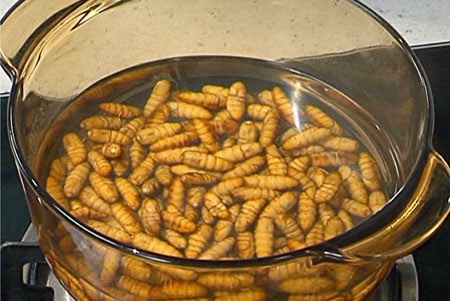Many villages in North Vietnam were famous with raising silkworms and harvesting cocoons, they feed the silkworms with mulberry leaves.
Silkworms are being feed with mulberry leaves
In the silkworms farm, thousand individuals of silkworms are being bred every day
Then they harvest the cocoon of silkworms to make the nature silk
The best quality cocoon are selected for the industry of nature silk
However they don't waste the remain cocoon after selection for silk, the pupa of the cocoon is released
In Vietnam, you can easy to find and buy pupa of silkworm in any local market, and it is one of the most common insect food in Vietnam. It known as a high protein food with very tasty and famous.
From the market, pupae are washed and quick boiled before being dried up
Lemon leaves were cut into tiny stripes
And the fresh onion leaves as well
The silkmoth pupae will be fried with lemon and onion leaves, sometime they add pepper and chilies. Lemongrass also can be added as an option. Fish sauce never lack as frying silkmoth pupae.
And today, in some Vietnamese families, they can make them with mayonnaise.













.jpg)
.jpg)
.jpg)
.jpg)
.jpg)
.jpg)
.jpg)
.jpg)
.jpg)
.jpg)
.jpg)
.jpg)
.jpg)
.jpg)
.jpg)
.jpg)
.jpg)
.jpg)
.jpg)






























